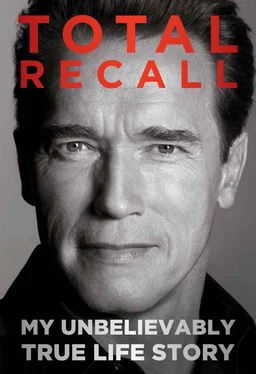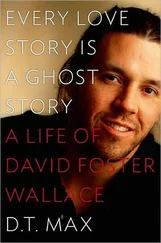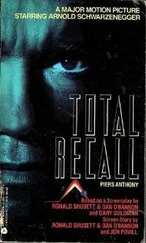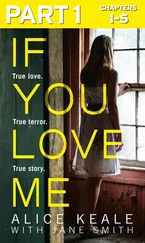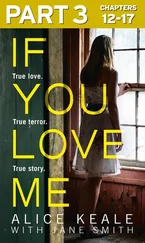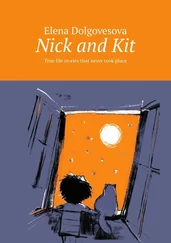My interests were so diverse that I could have ended up with a whole grab-bag of specialist advisors. Instead, I worked closely with an extremely smart investment banker named Paul Wachter, whom I’d known for years. Paul was a longtime friend of my brother-in-law Bobby Shriver’s—they became pals after law school in the 1970s while clerking for judges in Los Angeles—and we’d gotten quite close. You wouldn’t think I had much in common with a Jewish lawyer and banker from Manhattan’s Upper East Side who’d never been near a weight room or a movie set in his life. It seemed strange to other people how well Paul and I got along. But he had a strong Austrian heritage: his father was a Holocaust survivor from Vienna, and his mother was from a German-speaking part of Romania. German had been Paul’s primary language at home growing up. And his father, unlike many post–World War II immigrants, had maintained strong connections with the Old World. In fact, his business was importing and exporting ham and other meat products between the United States and places like Poland and Bavaria. Paul had spent his summers in Europe as a kid and later worked as a ski instructor in the Austrian Alps.
Compared to most Americans, he thought a lot like me. We both had alpine scenery in our blood: the snowy landscapes, the pine forests, the big fireplaces and chalets. For example, when I told Paul that I dreamed of building a large chalet overlooking LA for my family, he understood. We were both extremely competitive, and I would challenge him at tennis and skiing. From his father, whom I really liked also, Paul understood the immigrant mentality of coming to America and starting a business and making good.
So here was someone I trusted who was funny and athletic—a guy I could hang and schmooze with; ski, play tennis, and go golfing with; travel with; and shop with. Those things are important to me. I never like business relationships that are purely work. Maria and I are very different in that way. She grew up in a world where a sharp line was drawn between friends and the help. With me, there is almost no line. I find it valuable to work with people I can also be friends with, go river rafting with, go to Austria with and hike in the mountains. And I’m like a little kid who loves to show off and share things that I have experienced. If I go to the top of the Eiffel Tower for lunch and have an extraordinary meal, and someone comes with the cart with five thousand stogies in it, and I like the way they present the cigar and light it, I want all my buddies to experience that. So the next time I’m promoting a movie overseas, I’ll figure out how to arrange for some of them to come along. I want them to see the Sydney Opera House. I want them to see Rome. I want them to experience World Cup soccer games.
_
When I was doing the Planet Hollywood deal, Paul was my unofficial rabbi. He’d encouraged me to bring in my own lawyer when everybody else was using the company’s man. He’d also insisted that we take the time to do the deal right. We spent almost two years negotiating my ownership stake, and while the other stars focused mainly on including freebies and perks in their contracts, the arrangement I ended up with was more lucrative and had more safeguards built in in case the business went south. Over time Paul and the investment bank he worked for, Wertheim Schroder & Co., helped me on other deals. His official specialty at Wertheim was gaming and hotels; he’d sold golf courses, tennis clubs, and ski resorts. But I saw him in action enough to know that he had much greater range. No matter what was thrown at him—a production studio, a winery in Napa, California, a shopping mall development—he always cut to the heart of the deal. He was the quickest study I knew.
He and I had been working together informally for years when Ronda reached her limit. Common sense had been telling me that I needed to diversify beyond real estate, which was the only sector I really knew. The economy was booming, new companies and industries were starting up, and the stock market was expanding like crazy. I wasn’t interested in buying and selling stocks per se or spending my time researching companies. But I knew that the overall market had appreciated in real terms more than sixfold since Jimmy Carter was elected. I wanted to tap into that growth. Paul arranged for me to buy an ownership interest in a privately held mutual fund company called Dimensional Fund Advisers, which had offices right in Santa Monica. I met the founder, David Booth, a student of my hero Milton Friedman, and Paul couldn’t say enough good things about the business.
“I’ve seen hundreds of companies, but never a group of people like this,” he told me. “They are extremely ethical, they are brilliantly intellectual, and they are good businesspeople.” Though still small and under the radar, DFA was poised to dominate a part of the index mutual fund business that the industry giant, Vanguard, didn’t serve. I jumped at the opportunity, and Dimensional quickly became one of my most valuable assets.
I’d been pushing Paul to go out on his own, and in 1997 he set up shop in my building as an independent wealth manager with exactly one initial client: me. We understood each other so well by then that I gave him just a few instructions. The first was my old motto: “Take one dollar and turn it into two.” I wanted big investments that were interesting, creative, and different. Conservative bets—the kind that would generate 4 percent a year, say—didn’t interest me. Offshore corporations and other gimmicks didn’t interest me; I was proud to pay taxes on the money I earned. The more we paid the better, in fact, because it showed I was making more money. I also wasn’t interested in the investments that often attracted Hollywood business managers, such as trendy hotels and clubs. I could tolerate big risks in exchange for big returns, and I would want to know as much as possible about what was going on. My openness to new ideas and my involvement, plus the amount of money coming in, attracted Paul. He knew there would be plenty to do.
The idea of buying a Boeing 747 snuck up on us slowly. We had an acquaintance in San Francisco, David Crane, whose investment firm had gotten into the aircraft leasing trade. Aircraft leasing is a whole industry that exists because airlines often don’t like to own their airplanes. Owning ties up a lot of capital and can be a big distraction when your real business is flying around passengers and freight. So the airlines often lease the planes from somebody else. In a lease arrangement, the airline operates and maintains the plane for, say, eight years, and then returns it to the owner, who is free to sell it or lease it out again.
David’s firm was working with Singapore Airlines, which I knew had the best reputation in the airline business. It planned to expand its route system aggressively, and to free up capital, it was selling planes and leasing them back through contracts backed by Singapore government guarantees. I did some reading about airlines and leases and let it all simmer in my mind. Then one day I woke up, and the vision was crystal clear: “I’ve got to own one of those 747s!”
As far as I could tell, the opportunity was solid. I also felt a little of the same impulse that came over me when I saw my first Humvee. The 747 was the ballsiest airliner, and the price was as big as the plane. A new one cost anywhere between $130 million and $150 million, depending on the model and on options like the cabin and seating, cargo capacity, instrumentation, and so on. Of course, you wouldn’t pay the entire amount because buying a jet for lease is a little like buying a commercial building for lease. You invest, say, $10 million, and take out bank loans to cover the rest.
Читать дальше
